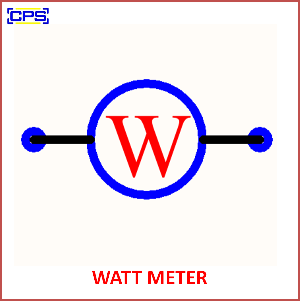A Wattmeter is an electrical instrument used to measure the power (in watts) consumed or produced by an electrical circuit or system. It calculates the rate at which electrical energy is converted to other forms of energy (e.g., heat, light, mechanical energy) and is typically used to measure the active power in both AC (Alternating Current) and DC (Direct Current) circuits.

Key Features of a Wattmeter:
- Power Measurement:
- The primary function of a wattmeter is to measure electrical power in watts, which is the product of voltage and current in a circuit, factoring in the phase difference between them (in AC circuits).
- Types of Power:
- A wattmeter can measure active power (real power), which is the power actually consumed by the circuit. It does not measure reactive or apparent power.
- Units:
- The unit of power measured by a wattmeter is watts (W), and it is often used to measure the power consumption of devices, systems, and electrical loads.
- Analog and Digital Wattmeters:
- Analog Wattmeter: Uses a mechanical movement (usually a moving coil or induction mechanism) to display the power reading on a scale.
- Digital Wattmeter: Uses electronic components and a digital display to provide a numerical reading of the power in a circuit.
Working Principle:
- A wattmeter works by measuring both the voltage and current in the circuit and calculating the instantaneous power at each moment. In AC circuits, the wattmeter also accounts for the phase difference between the voltage and current. The general formula for power PPP in an AC circuit is: P=VIcos(ϕ)P = VI \cos(\phi)P=VIcos(ϕ) Where:
- PPP is the power in watts.
- VVV is the voltage across the load.
- III is the current through the load.
- ϕ\phiϕ is the phase angle between the voltage and current waveforms.
In DC circuits, the phase angle is zero, and the formula simplifies to P=VIP = VIP=VI.
The wattmeter typically has two coils: one for measuring voltage (called the voltage coil) and one for measuring current (called the current coil). The interaction between these coils helps determine the real power in the circuit.
Applications of a Wattmeter:
- Power Consumption Measurement:
- Used in both residential and industrial settings to measure the electrical power consumed by appliances, machines, or entire facilities.
- Energy Monitoring:
- In power systems and electrical grids, wattmeters help monitor energy usage, ensuring that systems are operating efficiently.
- Testing Electrical Devices:
- Used in testing the efficiency of electrical devices, such as motors, transformers, and other electrical equipment.
- Laboratory and Research:
- In research, wattmeters are used to measure and analyze power in experimental setups, especially in the study of power systems and electrical circuits.
Advantages:
- Accurate Power Measurement: Provides an accurate reading of the real power consumed by the load, which is essential for energy management.
- Versatile: Can be used for both AC and DC circuits, with some wattmeters designed to measure both types of power.
- Useful for Energy Audits: Helps in calculating electricity usage and identifying opportunities for energy savings in various applications.
Disadvantages:
- Complexity in Calibration: Accurate measurement may require regular calibration to ensure precision, especially in analog models.
- Sensitivity to Power Factor: In AC circuits, the wattmeter is sensitive to the power factor, which may require correction for highly inductive or capacitive loads.
- Cost and Size: Digital wattmeters may be more expensive or bulkier compared to simpler analog models, although they offer more advanced features.
